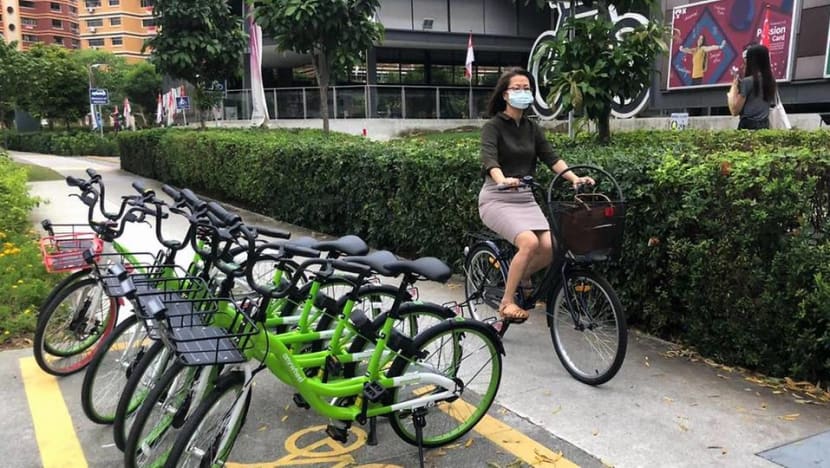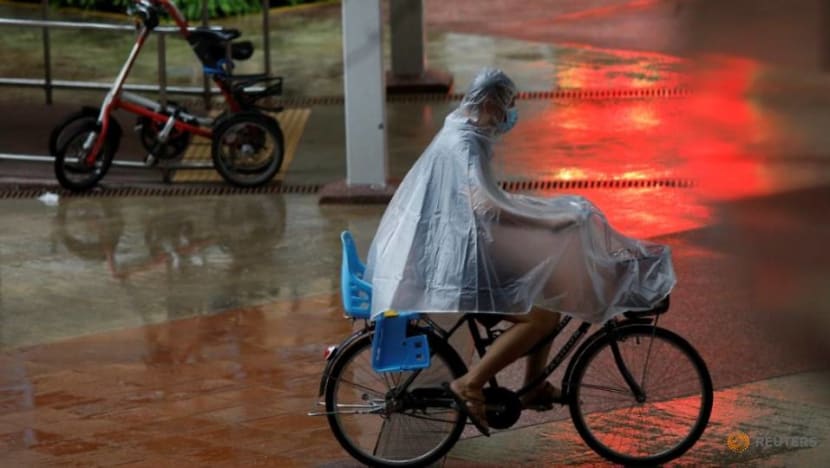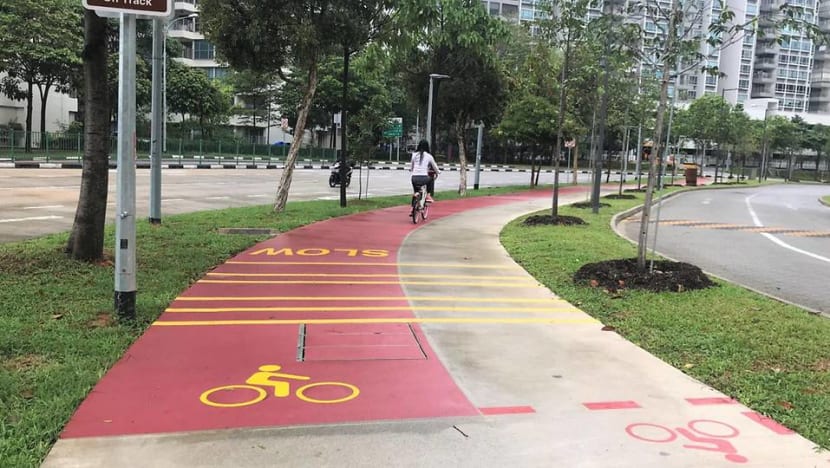Singapore sees cycling boom amid COVID-19, with increased ridership and bicycle sales

A woman cycling past a row of shared bicycles parked outside Our Tampines Hub. (Photo: Facebook/Baey Yam Keng)
SINGAPORE: Cycling has become more popular in Singapore amid the COVID-19 pandemic, with sales of personal bicycles going up and bike-sharing companies reporting an increase in ridership.
Bike-sharing operator Anywheel said its ridership increased every month this year, with the exception of April when the "circuit breaker" started.
There was a 68 per cent rise in ridership in January compared to the previous month, 25 per cent increase in February and 20 per cent in March, said the firm's chief executive Htay Aung.
Ridership fell by about 23 per cent during the circuit breaker but demand has since rebounded, with a 39 per cent increase between June and July, he added.
“We believe that the significant increase in ridership is mainly due to our growing fleet size as well as the shift in preference in mode of transport as members of the public are practising social responsibility by avoiding crowded areas during peak hours due to COVID-19,” said Mr Htay.
WATCH: COVID-19: Bicycle shops, bike-sharing services see more demand | Video
“Based on our trip data collected during this outbreak, our bicycles have been proven to be an alternative mode of first- and last-mile transportation and have the ability to replace short trips between one to two MRT stations or several bus stops,” he noted, adding that he believes the trend is likely to continue, speeding up Singapore’s “car-lite” ambitions.
In July, the Land Transport Authority (LTA) granted Anywheel approval to expand its fleet from 10,000 to 15,000 bicycles.

The largest player in Singapore's bike-sharing market, SG Bike, said it has seen more trips as well as longer use per trip, although it did not provide details.
“There is an increasing number of users using our bicycles as a means of outdoor exercise and activities,” said SG Bike marketing director Benjamin Oh.
“We see increased usage around neighbourhoods and outdoor parks such as along East Coast Park, Gardens by the Bay and the Marina Bay area,” he said, adding that SG Bike’s bicycles are cleaned and disinfected before deployment.
Food delivery riders have also contributed to the demand for the two-wheelers, Mr Oh added.
“Following the PMD ban and COVID-19 circuit breaker, we have continuously been working together with foodpanda to provide their riders to use our bicycles,” he said, adding that riders who work for other delivery companies also use their bicycles.
READ: 'We don't want the hype' : How homegrown operators aim to revive bike-sharing in Singapore
SG Bike operates a fleet of 25,000 bicycles here. It acquired Mobike’s bike-sharing licence last year, after the Beijing-based firm pulled out of the market.
A third bike-sharing operator, Moov, closed shop during the circuit breaker. It had been licensed to operate 10,000 bicycles here.
Cycling shops meanwhile have had a “strong year”, said OCBC group customer analytics and decisioning head Donald MacDonald, noting that sales increased before the circuit breaker period.
“People were rushing to get bikes before the lockdown so they could at least get out for fresh air,” he said.
The sale of bicycles and related accessories increased in the first quarter of this year, with 8,740 transactions compared to 5,187 during the same period last year, added Mr MacDonald, noting that virtual cycling classes also did well during the circuit breaker period.
For bicycle retailer Treknology3, sales for bicycles and accessories such as helmets and lights went up by about 20 to 25 per cent in the last few months, according to its marketing and distribution manager Azhar Abdullah.
He believes that the increased interest in cycling is because it allows people to head outdoors while maintaining safe distancing at the same time.
"They can exercise and maintain their health and wellness, and also have a bit of fun," said Mr Azhar, adding he expects the uptick in sales to continue until the first quarter of next year.
The growing interest in cycling is in line with the trend in other parts of the world as commuters turn to cycling to avoid crowded public transport.
Countries such as Britain and Italy, for example, have seen bicycle sales go up by 60 per cent during the pandemic.
READ: Boost for bikes as Europeans gear up for COVID-19 commute
GROWING THE CYCLING INFRASTRUCTURE
Even before COVID-19, Singapore has been putting more resources into developing the cycling infrastructure as part of its “car-lite” ambitions.
In March, then-Senior Minister of State for Transport Lam Pin Min announced that the Government expects to invest S$1 billion as part of plans to triple Singapore’s cycling path network to 1,320km by 2030.
Most residents living in Housing Board flats would be within 250m of a cycling path by 2026, Dr Lam said then.

In an interview with CNA938 on Aug 17, Member of Parliament for Tampines Baey Yam Keng added that the increase in cycling infrastructure would help discourage the use of cars, resulting in a positive impact on Singapore's carbon emissions level.
Tampines was identified in 2009 as Singapore's first cycling town.
In a recent Facebook post, Mr Baey said that the housing estate has added more cycling paths and bicycle crossings over the years. He also noted that shared-bike trips went up by more than 50 per cent in July compared to March, just before the circuit breaker period.
Singapore University of Social Sciences urban transport expert Park Byung Joon said the cycling boom may continue as people choose to avoid crowded trains and buses.
“I don't think cycling is going to be the main choice for commuters. But definitely we will see growth in bike usage,” he said, adding that the pandemic may also affect other aspects of transportation.
As telecommuting becomes more commonplace, traffic demand and public transport plans may have to be reviewed, he said.
"We may need a new, totally different approach,” said Associate Professor Park. “In my opinion, all mobility plans before COVID-19 need to be reviewed.”
BofA Securities analyst Rafe Jadrosich noted that the cycling boom amid COVID-19 has resulted in temporary supply chain inventory shortages for bicycle components.
"It's taking time for the supply chain to catch up," he said.
This is likely to ease by next month, he said, with inventory levels for bicycles likely to return to normal by early next year.
The cycling boom is still in its early stages and there is still a "long runway" for the trend, said Mr Jadrosich.
"We don't really see this peaking out anytime soon," he added.












